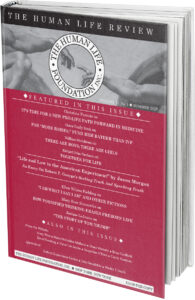Jesus’ Transfiguration—and Ours
The gospel reading for the second Sunday in Lent, this year on February 25 in the “Common Lectionary” (used by Catholics and several other churches), comes from St. Mark’s account of the transfiguration of Jesus, who took Peter, James, and John up a “high mountain” and there appeared before them with his clothes “dazzling white, whiter than anyone in the world could bleach them” (Mark 9:3). Jesus appeared before his disciples clothed in light, as they would remember later, when he told them, “I am the light of the world; he who follows me will not walk in darkness, but will have the light of life” (John 8:12).
The creation story in the book of Genesis declares: “God said, ‘Let there be light,’ and there was light” (Genesis 1:3). That first creative word was spoken into darkness: “The earth was without form and void, and darkness was on the face of the deep” (Genesis 1:2). Light into darkness; form into matter; the void suddenly illuminated; the first thing out of nothing—light. It is as though this ancient religious text were prefiguring the latest scientific theory of the universe’s origin—the “Big Bang.”
But the interest of Genesis is not in a scientific theory; it is in the way that the world in its original form reflects its creator: light, pure energy, from which all other creatures come to be. Man, the most developed of these creatures, is made in the creator’s image, possessing inner light as consciousness, intelligence, and freedom.
In the Prologue to his Gospel, John seems to be reprising the creation story when he introduces Jesus as no less than the divine creative Word, “Let there be light,” himself. This Word, John says, was “in the beginning . . . with God, and . . . was God. Through him all things came into being. . . . In him was life, and the life was the light of men. The light shines in the darkness, and the darkness has not overcome it.” Then, this “Word [“let there be light”] became flesh and dwelt among us, full of grace and truth; [and] we have beheld his glory . . .” (John 1:1-3a, 4-5, 14).
John, with his companions Peter and Peter’s brother James, momentarily beheld the light who is God—the “glory” of God’s creative Word—one day when Jesus “led them up a high mountain apart by themselves. . . . [and] was transfigured before them.” “Transfigured” means that his appearance changed dramatically: “His garments became glistening, intensely white.” It was a fleeting glimpse of who their friend and Master, their companion, truly was beneath the veil of human flesh: He was their God, who is light. Their friend and Master’s true identity had been revealed to them before, but indirectly—in Jesus’ luminous, authoritative teachings, in the bursts of divine energy that were his miracles, and in the warmth of his love, which gave them new life as they walked with him along the roads of Galilee.
Now Jesus was about to lead them on a different road—to Jerusalem, where they would see him betrayed by one of their own in the darkness of Gethsemane; tried, tortured, and executed at the hands of sinners. Then, they would remember his words: “This is the judgment, that the light has come into the world, and men loved darkness rather than light, because their deeds were evil” (John 3:19). Then, they would need the memory of their Lord transfigured before them; then, when they saw him die, they would need his reassurance: “I am the light of the world, and he who follows me will not walk in darkness, but will have the light of life” (John 8:12).
The “light of life” dawned upon the friends of Jesus when they met him in his resurrection. But now—at his tomb, in the upper room, on the road to Emmaus, and by the sea of Galilee—he was not transfigured. His appearance was ordinary: He showed them the wounds of his crucifixion; he conversed and ate with them. Jesus didn’t need to be transfigured once again, for he was risen from the dead. They knew he was their “Lord and God,” who would be with them always; their friend and companion; their light and their life. The three who had witnessed his transfiguration now became witnesses to his resurrection—not a momentary glimpse of glory, but a permanent possession, and a living hope of glory for themselves.
Jesus was transfigured once for a brief moment, and his disciples had a confirmation of their faith in him. But by his resurrection, his disciples were transformed. Their sorrow was turned to joy; their fear was turned to peace. The divine light that they had briefly glimpsed became their own divine life, to be shared and communicated in their mission. Their transformation brought the light of Jesus to a darkened world.
We walk in that same light, we who follow Jesus in the way of faith and charity. We walk in his light through the darkness of this world; and even though we cannot see the glory yet, we shall see it—and not just see the glory of the Lord, but share it, and be transfigured by it.









